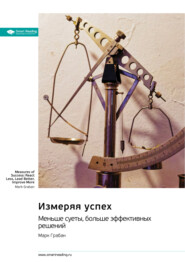По всем вопросам обращайтесь на: info@litportal.ru
(©) 2003-2024.
✖
Summary: The Emotional Compass. How to Think Better about Your Feelings. Ilse Sand
Настройки чтения
Размер шрифта
Высота строк
Поля
Smart Reading
Smart Reading. Ценные идеи из лучших книг
Notice: This is a SUMMARY of “The Emotional Compass: How to Think Better about Your Feelings” by Ilse Sand.
In the book, The Emotional Compass: How to Think Better about Your Feelings, Ilse Sand describes which emotions exist and gives us advice on how to recognize better understand what we are experiencing. Relying on her many years of practical experience, she gives tailor-made advice to people with various temperaments on how to deal with unpleasant emotions and avoid conflict situations, allowing them to live in harmony with their feelings and the people around them. She also stresses the importance of finding the right approach not only to those who have difficulty expressing their emotions, but to ourselves as well.
Summary: The Emotional Compass. How to Think Better about Your Feelings. Ilse Sand
Автор:
Ilse Sand
Оригинальное название:
The Emotional Compass. How to Think Better about Your Feelings
www.smartreading.ru
Labyrinth of Emotions
Many of us notice our feelings only after they have reached code red. "I can’t stand it anymore," "How is this even possible," "Don’t come near me." Sometimes we say these phrases many times a day without thinking what’s behind them and how they affect our relationships with our family, friends and colleagues. In succumbing to emotions, we lose the ability to empathize and evaluate the situation objectively. That leads to our making one mistake after another, and we put at risk the most precious things we have: relationships and our own inner peace.
But there is another extreme. Many people grow up not noticing their feelings at all. Some are afraid of conflicts, some try to please everyone, others cannot cope with strong feelings and choose to stuff them deep inside, preferably never to take them out again. But continually swallowing grief, ignoring sadness, suppressing fear and jealousy is a sure way to end up in a very bad emotional state, which can then grow into depression.
In her book "The Emotional Compass" Danish psychotherapist Ilse Sand teaches us to recognize emotions and feelings in their early stages. Such a skill will give you much more time to prepare yourself and choose how to respond. Sand worked with many different types of people: those who were ready to talk about their feelings all day long and those who were not at all inclined to self-reflection. Thanks to such a diverse experience she developed different ways of tackling the same tasks. In this book you’ll find not only real-world techniques that will help you figure out what you feel, but also examples of phrases you can use when talking to a person who has hurt you or whom you have hurt.
Ilse Sand states that emotions should not be divided into good and bad ones. All of them are useful, and by finding the real reasons why they appeared in the first place we can learn valuable lessons, even from such emotions as jealousy, envy, resentment and disappointment. And once you learn to differentiate between symptoms and the sickness, you can find a way out of the tricky and confusing labyrinth our feelings sometimes lead us into. Emotions are not always what they seem. Anger may hide deep sadness, while a soft smile may reveal a fear of being abandoned.
If you often get angry, shout, fight with your close ones or vice versa, or you cannot protect your boundaries, this book is for you. As Ilse Sand says, you can overcome anything. The main thing is to remember that we experience feelings, but are not defined by them.
Determine What You Feel
All feelings are divided into basic and mixed. Basic feelings are those that are experienced by all the people and even some of the more advanced animal species. Other emotions are either variations of basic feelings or a mix of them. Usually psychologists distinguish between four basic feelings:
▶happiness;
▶sadness;
▶fear/anxiety;
▶anger.
The better we understand what we feel, the easier it is to make decisions about how to react to this or that situation. If you are not sure about what you are feeling at any given moment, run a short analysis of the basic feelings:
▶Is there something I am angry about?
▶Is there something I am sad about?
▶Could I be scared?
▶Could I be feeling a slight tinge of happiness?
Very often we can’t determine what we feel until the feeling reaches a certain level of intensity. Using a scale of zero to 10, where zero is no feeling and 10 is the strongest level of feeling, it may be hard for us to detect what we feel if it is below five. But the earlier you discover what you feel, the more time it gives you to figure out what to do next. It is especially important to notice anger. Reaching your boiling point, you lose the ability to control yourself and be flexible in your thinking. One of the ways to recognize anger is to pay attention to your bodily sensations. You can illustrate your level of anger by using this scale below, listing emotions from the lowest intensity to the highest.
▶slight sensation of "I don’t like something";
▶irritation;
▶anger;
▶rage;
▶face getting red from rage;
▶face getting pale from rage.
Feeling intensity depends on how meaningful the relationship is. The more the person means to you, the angrier you are at him or her or, the happier you with him or her.
It’s also important to pay attention to the dominate thought. For example, if the dominating thought comes in tandem with a confusing feeling, for example "he treated me so unfairly", then, most probably, you are angry. Similarly, this occurs when you are judging other people and thoughts like "Where do they get off doing/thinking like that!!"
Another way of figuring out what you feel is to determine what you want. Every feeling has an impulse attached to it, a call for action. Ask yourself what your body feels now in a situation where something is bothering you. Imagine what kind of movement would have satisfied your body at this moment. For instance, if you feel restlessness in your legs, ask yourself what you think your legs would want to be doing right now. If you feel like runing, then you are probably anxious; if you feel like kicking something, then you are angry.
Remove the equals sign between yourself and your feelings. We have feelings, but we are not our feelings. Try to distance yourself from your emerging emotion and decide whether you want to succumb to it or not. Remember that you have this choice.
Distance Yourself From Your Thoughts
You cannot govern your feelings directly. For instance if you receive as a gift something that you clearly don’t like, you cannot make yourself feel excited about it. The only thing you can do is pretend that you’re happy. Similarly, you cannot deny your anger or rage. But you can affect them indirectly by channeling your thoughts. It’s important to remember that anything that’s happening is neutral by nature. We are the ones in charge as we control our perception. The author gives two pieces of advice regarding how to avoid the most widespread thought fallacies:
1. Think Realistically. Positive thinking is a great concept, but moderation is the key. Being excessively naive and believing that everyone wishes you well may lead you into trouble. If you create a positive filter between yourself and your reality, you may arrive at the conclusion that everyone likes you and soon you’ll be severely disappointed. The same is true for the negative thinking patterns. Audit your thoughts and try to determine which of them are truly yours and which belong to other people. Write down anything you can on paper and assess to what extent your thoughts regarding a certain situation are realistic. If in doubt, ask someone from your inner circle or talk to a professional psychologist.
2. Be Careful with Comparisons. The habit of comparing yourself with others is not too constructive. When comparting ourselves to others we tend to see ourselves not in the best light, and compare ourselves not with someone real, but with an adorned version of this person. Pay attention to what you tell yourself when you draw comparisons. Try to substitute "I haven’t attained this level, what is wrong with me?" with "What can I do to get there?" This way you’ll shift your focus of attention to your resources. If it didn’t help, go through everything good you already have in your life. It’ll definitely brighten your mood and you’ll confirm and fortify your values.
Find the Cause of Emotions
Anger
The author specifies four basic causes of anger:
1. Others say or do something that stings your ego. In this case all of us feel narcissistic anger. Still if people see you not the way you’d like them to see you, neither expressing your anger, nor attacking your opponent will help the matter. On the contrary, you may only make things worse, because anger is contagious. Even if the person didn’t feel anything negative towards you before, the anger coming their way will quickly make them angry as well. It’s best to say: "I’m sorry you see me this way. I see myself very differently". Most probably you’ll hear: "How do you see yourself?" This will help moving away from the blind conflict to a sensible conversation.
Behind narcissistic anger you often find fear of being abandoned. Gather some your courage and ask directly: "Does what you see in me make you like me less?" Most probably the answer will be "no", but during this conversation you’ll be able to clarify many things in your relationship.
If you were the one who attacked your opponent, whether deliberately or not, and caused narcissistic anger, try to show the person that you still see him or her in a positive light and one particular situation doesn’t change your overall relationship. This will quickly cool things down. When you want to give negative feedback, talk about actions, not the person. Don’t say "you’re stupid," say "you made a careless mistake."
2. Others offer you compassion or sympathy which you either haven’t asked for or are not ready for at the moment.

















